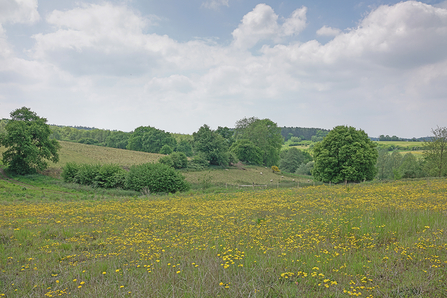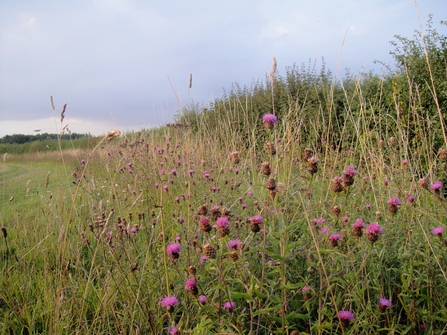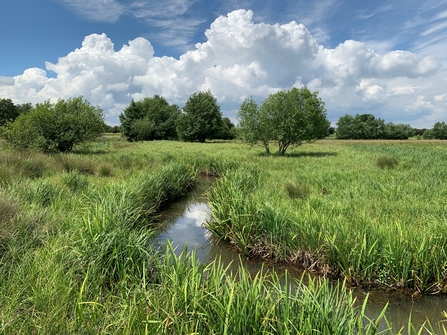For our 60th year, we’ve worked with illustrator Daniel Hilliard to create a landscape vision to show how Suffolk’s countryside could look if everyone considered nature in every decision we make. In September, we’ll look at our urban landscapes and how we can build nature into our decision-making to ensure everyone can live harmoniously with wildlife.
We have lost so much, but through the actions of every single one of us, we can bring nature back.
If we are to ensure that 30% of our land and sea is protected for nature and work towards achieving net zero carbon emissions, then a broad vision is needed to help us all get there. Business as usual cannot continue, and systemic changes are needed to make sure we protect what we have left and create ways to help isolated populations of species reconnect and travel freely once more throughout the landscape.
There are many benefits of a wilder Suffolk - where rivers are healthy, clean and thriving, where the whole county is connected by hedges, water courses and wild areas.
Instead of getting into a car to visit a nature reserve, wouldn’t it be great if people everywhere had access to wildlife rich green spaces as part of their everyday life? Where the air and water is cleaner, our food is nature friendly, our wildlife is thriving, and we are happy to see it enriching our lives. We are not fighting it, constantly sweeping it aside or hemming it in, we are part of it and it is part of us.
In our 60th year, we have witnessed great change. Many inspirational people have worked tirelessly to protect and restore Suffolk’s precious landscapes, habitats and species. However, the picture right now for our wildlife remains bleak – the losses sadly outweigh the successes – but, now more than ever, there is an air of change. Conservation and climate organisations across the world are coming together like never before to act together to influence policy and decisions to protect our shared natural world.
Suffolk Wildlife Trust has created a bold vision to bring wildlife back, and together with the Wildlife Trust movement, we aim to restore 30% of land and sea for nature by 2030.
What does a Wilder Suffolk landscape look like?
We’ve captured our thoughts in an image. A reflection of what a wilder Suffolk could look like: a place of beauty, rich in wildlife and us as part of it, where we give space for other species to thrive.
In parallel, later this year we are launching Team Wilder which aims to create a tipping point of change for wildlife. We’re aiming to get 1 in 4 people doing their bit for wildlife in Suffolk to create societal change and build momentum towards a sustainable, healthy future for us all.

Suffolk landscape vision - Daniel Hilliard
Click here to enlarge
Nature reserves
Our nature reserves are the arks from where wildlife can spread out into to other areas – but only if they are well connected by hedges, woods, wild areas and rivers...

Arger Fen - Steve Aylward
Bringing life back to our rivers
Our rivers are the life-blood running through the whole county. We’ve been working for years to help improve water quality by collaborating with farmers and landowners to reduce agricultural runoff, to improve riverbanks and to help reconnect rivers with their floodplains. Our Water and Wildlife campaign will continue to help offer advice and on-the-ground action to create healthy, thriving rivers, which, ultimately will be of huge benefit to our estuaries, too. Rivers not only support a vast range of species, particularly insects, but also act as natural corridors. They are precious blue lines that connect our county together and allow wildlife to move safely through it. We are expanding our river work to cover more rivers across the county, creating better habitats for fish and insects and planting riverside trees to reduce erosion.
Little Ouse at Knettishall Heath - Steve Aylward
Clean seas
Suffolk has a beautiful, low-lying coastline that constantly changes. We have some specialist species perfectly adapted to our moving coastline, but our beaches and our coast is under constant pressure through hard structures, development and disturbance. We are working hard to reduce the impact of development and disturbance, making sure more resources are available to protect these precious areas. At sea, we only have one protected area off Suffolk’s coast, the Orford Inshore Marine Coastal Zone. We are collecting data to help understand how important this area is, with a view to protecting it from damaging activities.
Yellow horned poppy - Steve Aylward
Wild farms
Suffolk is about 80% agricultural land, so nature on farms needs to thrive if we are to achieve our vision for a wilder Suffolk. We are working with farmers to help them grow food whilst providing habitat and a healthy environment for wildlife, and crucially, creating nature networks between farms to allow animals to move safely through the landscape. Across Suffolk we are restoring farmland ponds, planting species rich hedges, encouraging the reduction of pesticide use, advising on management that reduces agricultural run-off, and creating meadows rich in wildflowers. Through our work we expect to see more birds such as skylark and yellowhammer, more Insects such as butterflies and dragonflies and more mammals such as hedgehogs on the farms we visit.
We have inspired many wildlife-friendly farmers in Suffolk who are doing all they can to bring nature back to their farms while remaining productive.
Wildlife friendly farming - Steve Aylward
Hedgerows
Hedges allow animals to move in safety across landscapes, provide food and shelter and habitat for a huge range of species, and help prevent soil erosion by wind and rain. At the moment, most of our hedges are flailed too hard and too often and provide very little benefit for wildlife that depends on them. Many have been grubbed out to create vast fields which become uncrossable deserts for wildlife. Those that remain are too controlled and often lack standing trees. We need to allow our hedges to flourish again, and put them back where we can to act as natural connectors for wildlife. The hedgerow elms that were lost 40 years ago have never been replaced and we are now losing tens of thousands of ash trees. We need a plan to replace these trees in the Suffolk landscape.

Hedge - Steve Aylward
Ponds
Water is essential for life and we’ve been slowly removing water from our landscape, filling in ponds to make way for crops, burying streams, draining fields, forcing rivers to stay static by embankments. Suffolk is one of the most pond-rich counties and this is then reflected in species which have a stronghold here, such as great crested newt. We’re working with wildlife-friendly farmers to help restore and improve farmland ponds – which contain a host of botanical diversity and are vital for insects – many of which have an aquatic life stage and provide much needed food and water for many species.

Pond - Sam Hanks
Meadows and Grasslands
We need to free ourselves from the tyranny of tidiness! ‘Scruffy’ patches of grass are brilliant for wildlife. Wildflowers, too, are fantastic for pollinators and insects such as butterflies and moths. It’s brilliant to see many people saying ‘no to the mow’ in May and councils are now much more aware of the value of wild road verges, roundabouts, and urban green spaces. We have hundreds of miles of potentially wildlife rich road verge if we could just change the way we view and manage these areas. We have lost 97% of our wildflower meadows in the UK. However, it is possible to reverse this shocking loss. Our meadows provide botanical diversity and well as an important resource for insects and birds.
Wildflowers - Steve Aylward
Trees
We need lots of them, but we need the right species in the right places. Ancient woodlands, with areas of successional scrub, dead wood – standing and fallen – are incredibly valuable for wildlife and must be protected. For new plantings, a mix of native species adds resilience to the landscape but the important role that veteran trees have in the landscape cannot be overstated. A new approach to creating woodlands is rewilding – letting nature naturally wild-up an area – you can see this in action at our Arger Fen and Spouses Vale reserve and at Black Bourn Valley.

Veteran oak tree at Captain's Wood - Steve Aylward
Wild areas
Successional scrub, un-managed areas and rough brambly vegetation are vital habitats for wildlife such as nightingale and turtle dove. We must resist the urge to constantly ‘tidy up’ the countryside by cutting every field margin, verge and hedge. Let’s be less tidy and go wild!

Field margin - John Pawsey
Marsh and Fens
Low-lying marshes and fens are fantastic for carbon capture, reducing flooding and are home to a huge variety of wetland species. Wet, marginal habitats are currently lacking, so to see more of these habitats could really help populations of birds such as curlew and lapwing.

Darsham Marshes - Steve Aylward
It is possible to realise this vision for a better-connected landscape with greater abundance and diversity. In September, we’ll look at the urban landscape and how changes in approaches can allow people and wildlife to live together in harmony to the benefit of everyone and everything.

